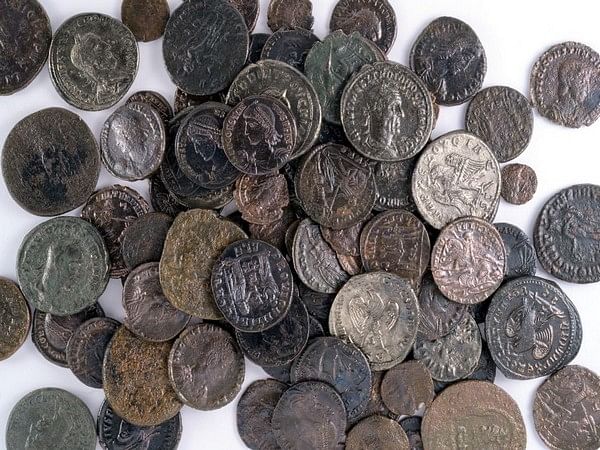Tel Aviv [Israel], June 19 (ANI): The discovery of a large, 1,650-year-old public building and a hoard of coins at an excavation in Lod provides the first compelling evidence of the little-known Gallus Revolt against Rome, the Israel Antiquities Authority announced on Sunday.
The 94 silver and bronze coins, dating from 221 to 354 CE, were hidden in the building’s foundations and likely intended to be retrieved once the turmoil subsided. The most recent coins correspond to the Gallus Revolt (351-354 CE), marking the building’s destruction during this turbulent period. Historical texts, though sparse, mention that significant Jewish communities, including Lod, Zipori, and Tiberias, faced severe destruction by the forces of Roman Caesar Flavius Constantinus Gallus.
This revolt occurred around 351-352 CE, two centuries after the better-known Bar Kochba revolt. The Gallus Revolt was more localized to the Galilee and was the last Jewish uprising against the Roman Empire.
The building, adorned with impressive stone and marble artifacts, contained inscriptions in Greek, Hebrew, and Latin. One inscription, currently under study, bears the name of a Jewish man from a priestly family. The absence of pig bones among the site’s bone assemblage further indicates the building’s Jewish origins.
Excavation leaders Shahar Krispin and Mor Viezel of the Antiquities Authority suggested that the building served as a significant Jewish communal center.
“In all likelihood, this is a magnificent Jewish building that housed the city’s elders,” Krispin and Viezel said, noting that historical records from the Talmud mention Lod as a crucial Jewish center following the destruction of the Second Temple in Jerusalem.
“The building’s destruction down to its foundation indicates that the revolt was suppressed with significant violence and was not merely a local uprising,” they stressed. “This discovery is a singular witness to the extent and power of the revolt in Lod, located in the country’s center.”
According to Prof Joshua Schwartz, chairman of the Antiquities Authority’s board, “The building’s size, the coin hoard, and the array of archaeological finds fit well with Lod/Diospolis’ description in both Jewish and non-Jewish sources as a center of Torah-true Jewish life during the Mishna and Talmud periods. Lod’s role as a leading community with elders continued from after the destruction through to the moment it was cruelly cut down in the Gallus Revolt.”
Lod Mayor Yair Revivo called the discovery “an emotionally moving find.”
Said Revivo, “The findings prove that Lod is one of the oldest cities in the world. We thank the Israel Antiquities Authority for revealing our city’s past glory.” (ANI/TPS)
This report is auto-generated from ANI news service. ThePrint holds no responsibility for its content.




